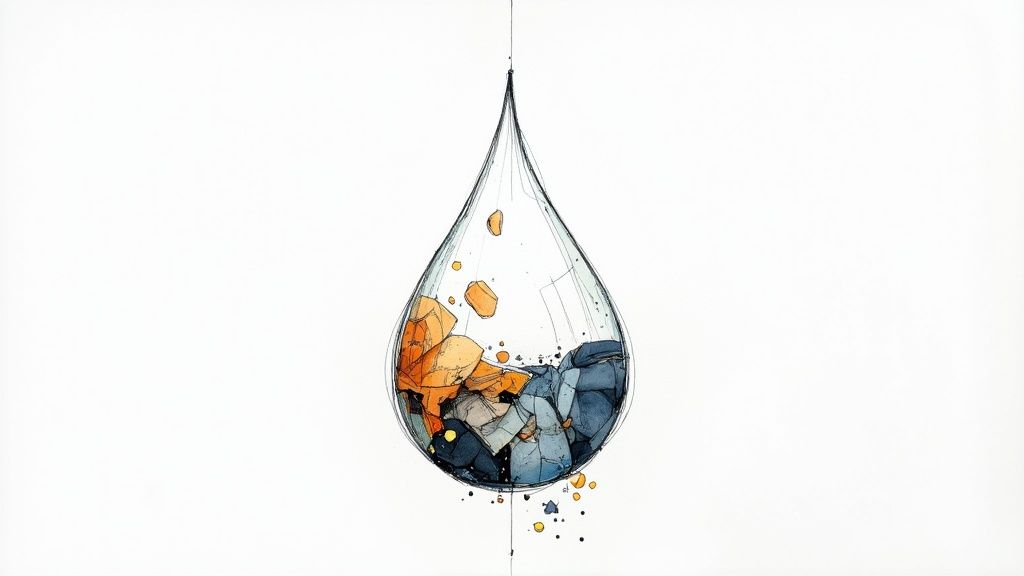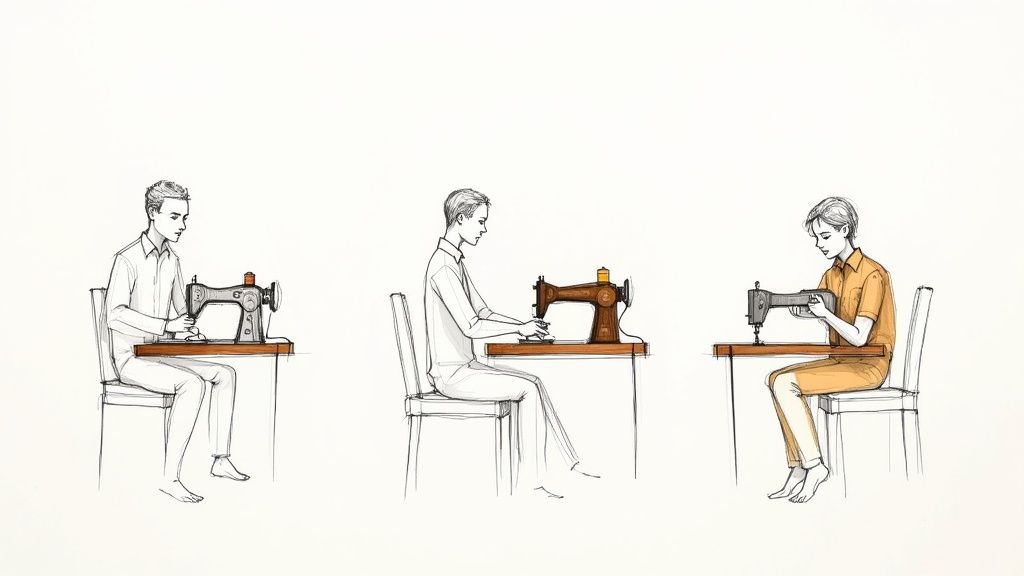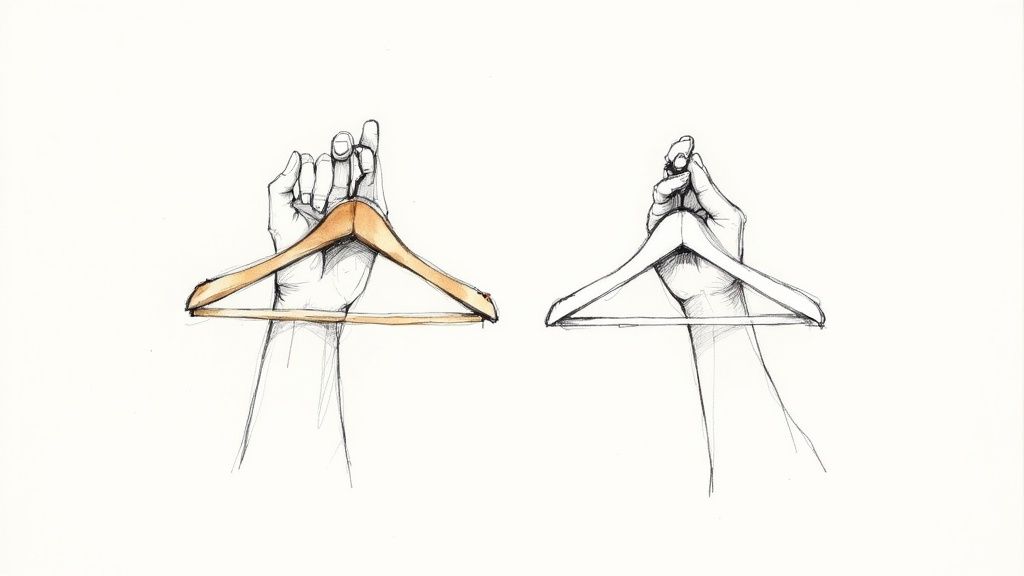Think of fast fashion as the clothing equivalent of fast food. It’s cheap, it’s quick, and it offers a moment of satisfaction, but it’s ultimately designed to be disposable. This mindset is especially worrying when it comes to the clothes we put on our babies.
What Is Fast Fashion, Really?
At its heart, fast fashion is a business model that puts speed and low cost above everything else—including quality, safety, and ethical standards. For parents, this usually translates into an endless churn of buying cheap baby clothes that look worn-out after just a handful of washes. They shrink, lose their shape, or simply fall apart at the seams.
These clothes aren't made to last. They’re designed to be thrown away. This approach hinges on a few key things:
- Non-Stop Trend Cycles: Brands push out new "micro-trends" every few weeks, creating a sense of urgency to buy the latest cute outfit before it’s gone.
- Poor-Quality Materials: To hit those impossibly low prices, manufacturers rely on cheap materials. This often means using resource-heavy conventional cotton or mixing it with synthetics like polyester. If you're curious about the specifics, our guide on the difference between natural and synthetic fibres breaks it down.
- Temptingly Low Prices: That bargain-bin price tag on a babygrow feels like a win, but it hides the true environmental and human cost behind its production.
The entire fast fashion system is built on the idea that clothing is disposable. This philosophy is the complete opposite of what most parents want: safe, durable, and comfortable clothes for their children.
This constant cycle of production and disposal has reached a staggering scale. The image below paints a clear picture of how high-volume manufacturing and short garment lifespans lead directly to mountains of waste.

The numbers are shocking. The fashion industry generates an estimated 92 million tonnes of textile waste every single year.
Once you start seeing these patterns, it becomes much easier to understand why a different approach is so important—one that values quality craftsmanship, timeless style, and passing clothes down. That’s the philosophy we live by here at Little Novice.
The True Cost of a £5 Babygrow

When you spot a multipack of babygrows for a fiver, it’s easy to feel like you’ve scored a bargain. Who wouldn't? But the real price isn't on that tag. The true cost is hidden along every step of its journey, from a cotton field far away to your baby's nursery. Understanding this hidden journey is the key to grasping why what is fast fashion is such a massive problem, particularly when it comes to clothes for our little ones.
The story of that cheap garment almost always starts on a farm. We think of cotton as soft and natural, but producing it at the breakneck speed fast fashion demands is a different story altogether. It's a thirsty crop, and conventional farming guzzles enormous amounts of water while relying on a cocktail of chemical pesticides and fertilisers to get the biggest harvest possible.
Those chemicals don't just disappear. They leach into the soil and pollute local rivers and streams, causing lasting damage to the environment. This is the first hidden payment for that cheap piece of clothing, made long before the cotton is ever spun into thread.
From Field to Factory
Once the cotton is picked, it’s shipped off to a factory. Here, it’s subjected to even more chemical processes – bleaching, dyeing, and finishing to get that bright colour or soft feel. The dyes needed to create those trendy, eye-catching shades for baby clothes often contain heavy metals and other harsh chemicals.
All of this creates a huge amount of polluted wastewater, which is often released back into the environment, devastating aquatic life. It's a world away from the pure, gentle image we want for our baby's clothing. The entire system is built for speed and low costs, not for quality or safety.
The path of a fast fashion garment is paved with environmental shortcuts. From water-intensive farming to chemical-laden dyeing, the low price is made possible by offloading the ecological cost onto the planet.
This is where the difference really shows. A thoughtfully made garment, like those from a conscious brand such as Little Novice, follows a completely different path from the very beginning. We focus on designing timeless, beautiful pieces with real care, using high-quality cotton materials.
Our approach means the clothes are not only soft and safe for your baby’s delicate skin but are also made to last through countless tumbles and washes. They’re designed to be passed down, creating a beautiful cycle of reuse that respects both the planet and your wallet. It’s about choosing lasting value over a fleeting bargain.
Microplastics: The Invisible Risk in Your Nursery

Beyond the obvious problems of landfill waste and pollution, fast fashion brings a more subtle danger right into our homes—especially the nursery. It's a risk so small it's invisible, and it comes from the very fabrics meant to keep your little one comfortable. We’re talking about microplastics.
A huge amount of fast fashion babywear is made from synthetic fabrics like polyester and acrylic, often blended with cotton to keep costs down. They might feel soft initially, but these materials are, at their core, plastic. Every time you wash them, they shed thousands of tiny plastic fibres.
These microscopic fibres are too small to be caught by water treatment filters, so they flow directly into our rivers and oceans. But the problem doesn't stop there. They also become airborne and settle as household dust on our floors, rugs, and furniture—exactly where our babies spend most of their time.
Why Are Microplastics a Concern for Babies?
Babies are explorers. They get to know their world by touching, feeling, and often, tasting everything within reach. They crawl and play on floors where dust, and the microplastics within it, inevitably gathers. Because of their constant hand-to-mouth behaviour, their risk of ingesting these particles is much higher than an adult's.
While researchers are still working to understand the full long-term health implications, one thing is certain: synthetic, plastic-based fibres simply don't belong in a baby's environment, let alone their bodies. Choosing natural materials is one of the most direct ways to reduce this hidden risk.
Creating a safer space for your baby begins with paying closer attention to the fabrics you choose. If you want to dig deeper into why material choice matters so much, it’s worth exploring the differences between polyester microfiber and natural bedding.
This is precisely why at Little Novice, we are committed to using high-quality cotton. It’s a pure, natural, and breathable fibre that won't release plastics into your home. We believe baby clothes should be beautifully simple, made from quality materials with genuine care. Our timeless designs can be washed time and again without shedding harmful microplastics, ready to be loved, passed down, and reused—creating a cycle of sustainability, not pollution.
Let's be honest, to understand why a small choice for your baby can make a big difference, you first need to see just how big the machine you're up against is. Fast fashion isn't some fringe concept; it's the engine driving almost every UK high street and online store. It shapes what we buy, how we buy it, and how often we buy it—often without us even noticing.
The numbers are staggering. The UK's fast fashion market is on track to be worth around £10.9 billion by 2025. This isn't just a business; it's an economic behemoth, dominated by household names like Primark, ITX UK (who own Zara), and ASOS. Together, they set a relentless pace. You can dig deeper into the UK's fast fashion market size on IBISWorld.
Their entire model relies on getting you to buy more, faster, for less. It creates an almost irresistible pull, especially when you're a knackered parent who just needs an affordable outfit for a baby who seems to outgrow things overnight.
Making a Deliberate Choice
This is why choosing sustainable babywear is such a powerful act. It’s a conscious step away from that high-speed, throwaway culture. It’s looking at the influence of these giant brands and saying, "No, thank you, I'm looking for something different." It’s a choice to value quality over quantity, timeless style over fleeting trends, and natural fabrics like cotton that are designed to be loved, worn, and passed on.
This isn't about perfection or boycotting every high street shop. It's simply about awareness. It’s knowing that every beautifully made, durable cotton piece you choose for your child is a small but vital vote for a better way of doing things.
The good news? You're not alone. A growing number of parents are asking what is fast fashion and starting to look for brands that reflect their own values. This shift is creating a real space for thoughtful, sustainable alternatives to take root and grow.
The Lasting Value of Timeless Babywear
When you see the real problems caused by throwaway trends, the solution starts to feel refreshingly simple: buy less, but buy better. This idea is the very heart of slow fashion, a movement that directly pushes back against the frantic, wasteful pace of the fast fashion industry. It isn't about chasing expensive labels; it’s about investing in quality, durability, and classic design.
This shift in mindset completely changes how we think about baby clothes. Instead of viewing them as disposable items meant to be worn for a few short months, we start seeing them as valuable, long-lasting assets. This is where high-quality cotton really proves its worth for parents trying to make more conscious choices.
Crafted to Endure, Designed to Be Loved
Thoughtfully designed cotton clothes are built for the reality of being a kid. They're made to withstand messy mealtimes, endless crawling adventures, and countless cycles in the washing machine. Unlike fast fashion pieces that often lose their shape and softness after just a few washes, quality cotton holds up beautifully.
The goal is to create clothes that last for years, not just a single season. A well-made cotton bodysuit or sleepsuit can be worn, loved, and still look fantastic, ready to be passed down to a younger sibling or a friend's new baby.
This approach transforms baby clothes from simple garments into cherished keepsakes. They become carriers of precious memories, passed from one child to the next, creating a beautiful and sustainable cycle of reuse.
Ultimately, this shift offers far better value for your money. A single, well-made item that lasts through multiple children has a much lower "cost-per-wear" than a dozen cheap outfits that need to be replaced over and over. It's a smart investment for your wallet and a kinder choice for the planet. For parents embracing this philosophy, some good minimalist closet organization tips can really help extend the life and usefulness of their babywear collection.
At Little Novice, this is the principle that guides everything we do. We design timeless, unisex baby clothes using quality cotton that is soft, durable, and free from the hidden risks of fast fashion. Our pieces are created with care, intended to become part of your family’s story and passed on with love. This is our answer to the question of what is fast fashion: a firm commitment to creating a better, more sustainable alternative.
Why Quality Cotton Is a Parent’s Best Ally

When you're trying to sidestep the pitfalls of fast fashion, especially with a little one at home, high-quality cotton is a genuine hero. A baby’s skin is incredibly delicate—it's thinner and far more sensitive than ours. This means the fabric you choose is more than just a matter of comfort; it's about wrapping them in something gentle and safe.
Pure, premium cotton is naturally soft, breathable, and kind to the skin. It’s a world away from the harsh, chemically treated fabrics that are so common in the fast fashion world. But here's the catch: not all cotton is created equal. The cheap cotton found in most low-cost baby clothes is often blitzed with chemicals to rush it through production. Higher-quality cotton, on the other hand, preserves the natural integrity of the fibre, giving you a fabric that’s not only softer but also much, much more durable.
The Value of Durability and Timeless Design
This is where quality cotton really proves its worth, particularly for parents who are tired of the throwaway culture of baby fashion. Clothes made from superior cotton are built to last. They keep their shape and softness through countless washes and tumbles, refusing to thin out or fall apart like their cheaply made counterparts.
This incredible resilience makes them perfect for a 'pass-it-down' lifestyle.
- Long-Lasting Wear: These clothes maintain their quality, meaning they can be worn by one child and still look fantastic for the next.
- Timeless Appeal: By focusing on classic, simple designs instead of fleeting fads, these pieces never feel dated.
- A Cycle of Reuse: Each item is made with the intention of being passed on to another child, which cuts down on waste and creates a lovely legacy of shared use.
At Little Novice, we live by this philosophy. We create timeless, unisex pieces using quality cotton, designed to be gentle on your baby's skin and tough enough to be passed on. We believe clothes should be part of a family's story, not part of a landfill.
Exploring why 100% cotton clothes are better offers even more insight into making the right choices. And it’s not just about cotton; other natural fibres like bamboo as a beneficial fabric for babies also bring fantastic benefits to the world of babywear.
Your Questions About Sustainable Baby Fashion, Answered
Deciding to move away from fast fashion for your little one naturally brings up a few questions. You might be wondering about the price tag, whether it’s practical, or just how to tell the good stuff from the throwaway stuff. Let’s clear things up so you can feel confident in your choices.
Isn't Sustainable Baby Clothing Just More Expensive?
It’s true that the upfront cost can be higher, but it’s a bit like buying good-quality batteries versus cheap ones. The real value is in how long they last.
A well-made cotton outfit that can handle dozens of washes has a much lower 'cost per wear' than a cheap alternative that warps or fades after just a few spins in the machine. Think of it as an investment in durability that saves you from buying replacements over and over again.
What's the Point in Buying Quality When They Grow So Fast?
That’s exactly why quality is so important! Fast fashion treats baby clothes as disposable, single-use items. Sustainable, well-crafted pieces are designed with a longer life in mind.
A beautiful, timeless garment holds its shape, colour, and softness, making it perfect for passing down. It can be worn by a younger sibling, gifted to a cousin, or passed on to a friend’s new baby. This creates a lovely cycle of shared memories and keeps perfectly good clothes out of the landfill.
How Can I Spot a Fast Fashion Item?
There are a few tell-tale signs. An unbelievably low price is usually the biggest giveaway, as it often points to cheap materials and compromised ethics somewhere along the line.
Next, check the care label. Fast fashion often relies heavily on synthetic fabrics like polyester, even if it's blended with a bit of cotton. Finally, notice the shop's pace—if they’re churning out new "micro-trends" every single week, that’s a classic fast fashion model.
On the other hand, conscious brands tend to move at a slower, more thoughtful pace. They focus on smaller, curated collections built around timeless designs and natural, high-quality materials. It's about creating clothes with care, made to be cherished, not discarded.
At Little Novice, this thoughtful approach is at the heart of everything we do. We offer timeless, unisex clothes made from quality cotton. These pieces are designed with care and quality materials so they can be reused again and again and passed down to the next child. Explore our collection and discover a more sustainable way to dress your child at https://littlenovice.co.uk.
Article created using Outrank